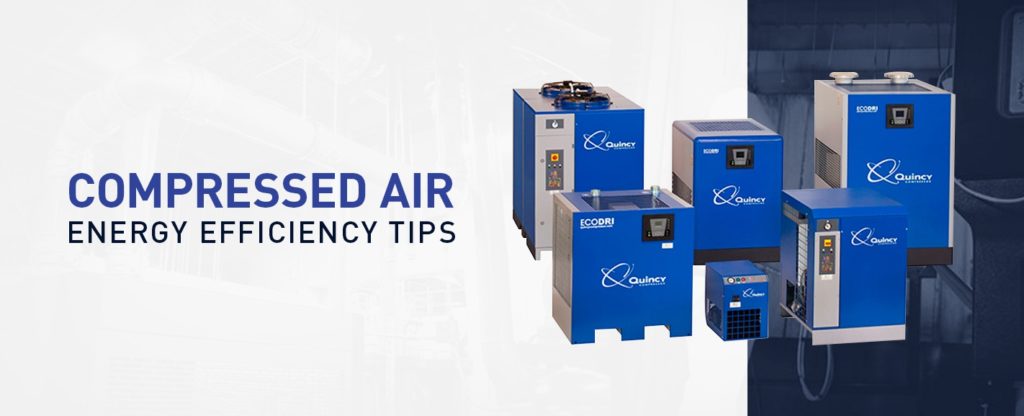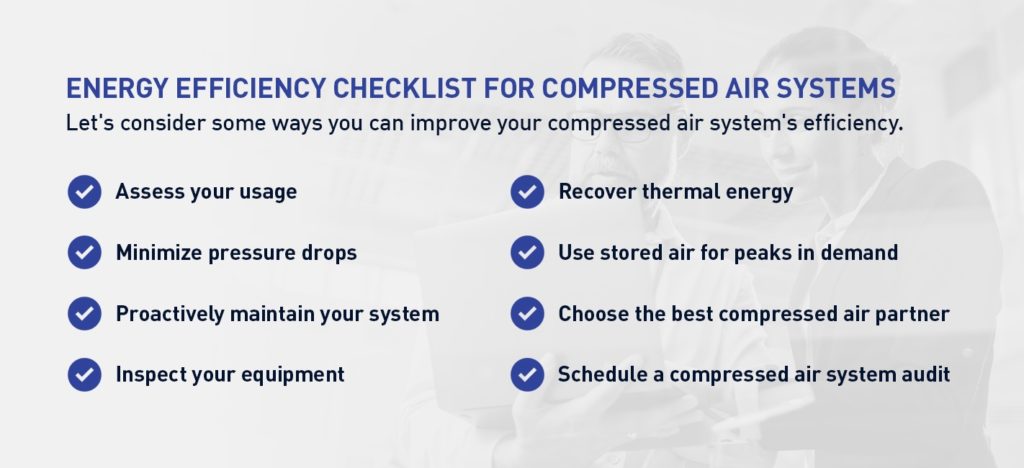September 16, 2020
Compressed Air Energy Efficiency Tips
SHARE THIS POST

Compressed air helps businesses accomplish a wide range of industrial tasks, but many of these businesses are unaware of how much energy they are wasting through their compressed air system. According to the Compressed Air and Gas Institute (CAGI), inefficient compressed air systems can result in over $3 billion of wasted utility costs in the U.S. annually.
The efficiency of air compressor systems depends on a variety of factors. We’re going to look at the importance of compressed air efficiency improvement and how to improve air compressor efficiency so you can start saving money and enhance your operations.
Importance of Having an Efficient Compressed Air System

When you purchase new equipment, you may consider the initial price tag and even budget for ongoing maintenance, but did you know that 76% of an air compressor’s total life cycle costs comes from electricity usage? Even in the first year of using a new air compressor, operating costs can easily exceed the initial cost of the equipment.
Compressed air is also one of the most expensive forms of energy in an industrial plant. It takes seven or eight horsepower of electricity to generate just one horsepower of compressed air. Considering the amount of electricity companies use to operate their compressed air equipment, it’s easy to see how inefficient equipment or usage can cost you significantly in the long run. By the same token, an efficient air compressor and strategic usage could help you stack up a great deal of savings over time.
Common Sources of Inefficiency in Compressed Air Equipment
Inefficiencies in a compressed air system often lead to wasted compressed air and unnecessary costs. The efficiency of air compressor systems is typically compromised by several issues. One of the biggest issues is production inefficiencies. This can account for nearly half of the wasted air in an industrial plant.
Another major issue, according to the Department of Energy, is leaks. In a poorly maintained system, leaks can result in 20%-30% of a compressor’s output going to waste. In contrast, a well-maintained system may only experience losses of 5%-10%. Even a small leak can waste millions of cubic feet of air over the course of a month.
The Department of Energy identifies other issues that can lead to wasted air, including artificial demand and inappropriate use. Artificial demand occurs when compressed air equipment is set to supply a higher pressure than necessary for a particular application. Inappropriate use is when workers opt to use compressed air for a task that could also be accomplished with a different, more economical energy source.
Though there are many opportunities to waste compressed air in an industrial setting, each of these opportunities is also a chance to make strategic choices to limit waste and make your operations as efficient as possible.
Energy Efficiency Checklist for Compressed Air Systems

Let’s consider some ways you can improve your compressed air system’s efficiency. There are multiple ways to approach this issue and start saving money right away:
- Assess your usage: It’s wise to take stock of your operations and your use of compressed air. Determine how much compressed air you need to use and how much you are actually using. This is a good way to establish a gap in efficiency. Make sure your system only draws the amount of pressure needed from the air compressor, and look for any issues of inappropriate usage.
- Minimize pressure drops: Pressure drops can cause inefficiency in your system, so preventing them is always a good idea. One way you can minimize pressure drops is by designing your system to get your air from point A to point B in the shortest distance possible. Another is to ensure your piping is properly sized so it can accommodate maximum flow rates.
- Proactively maintain your system: It’s critical you give your compressed air equipment the ongoing care it needs so it functions efficiently. This includes lubricating it regularly and changing the air filter as soon as it begins to be clogged by dirt and dust. You should also maintain drying equipment so your system isn’t subject to moisture that could cause rust.
- Inspect your equipment: Routinely inspecting your system can alert you to issues like leaks that can contribute significantly to inefficiency. Catching these issues early allows you to address them so they don’t have a chance to cause significant energy losses. Look for any loose fittings, signs of corrosion, loose v-belts or any other issues that could affect your system’s efficiency.
- Recover thermal energy: Air compression produces heat. This byproduct normally goes to waste, simply dissipating into the air and adding to the burden on your cooling system. By implementing an energy recovery system, you could put that thermal energy to use in your industrial plant. For example, you could harness it to heat your building in the winter or to heat water for washing processes.
- Use stored air for peaks in demand: You should also look for opportunities to implement technology to help you enhance your compressed air system’s efficiency. A pressure regulator or flow controller, for instance, can help you operate at lower pressures and use stored compressed air when you hit usage peaks. An air receiver tank can also help you temporarily store air so you can meet spikes in demand without keeping your system set at a higher pressure than necessary.
- Choose the best compressed air partner: If you’re purchasing compressed air equipment for the first time or redesigning your system, make sure you choose the right company to purchase your equipment from and work with. Look for a company that can help you maximize your system’s efficiency. Ask for examples of how they have done this for other industrial companies like yours.
- Schedule a compressed air system audit: In order to improve your system’s efficiency, you need an informed understanding of the problem areas you need to address. A system audit is a smart move since professionals with a wealth of experience and the right equipment can provide the data you need concerning your usage and equipment. When you schedule an audit with C.H. Reed, you can rest assured we’ll approach the issue from many angles to help you optimize your system’s performance and efficiency.
Boost Your Efficiency With Help From C.H. Reed
The experts at C.H. Reed have the experience, tools and insights necessary to help you identify cost-saving opportunities with your compressed air system. By investing in improving your system, you could save your company a significant amount of energy and money in the long term. Contact us today to schedule an audit or ask for help with your other compressed air needs.
Search
Categories
Get a consultation
Related Posts
The 3 Distinct Advantages of Hydraulic Powered Pumps
Recently, C. H. Reed helped a major printing operation install a new ink pumping system. The new system needed to transfer four colors of high viscosity, heat-set ink to their three presses, drawing the ink from multiple 5,000…
Simple Ways to Reduce Waste in Your Spray Finishing System
In today’s demanding manufacturing landscape, it can be convenient to adopt a “cut-costs-at-all-costs” mentality, justifying questionable means for the sake of leaner production, a lower bottom line and increased profitability. Regrettably, those efforts can interfere…
What You Need to Know About Air-Powered Pressure Washers
Pressure washers are great solutions for your average cleaning applications, but what tool do you turn to for your more challenging applications? There are many instances where it is simply impossible to use a traditional…